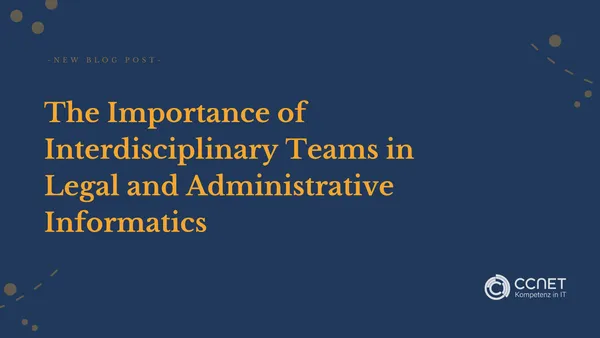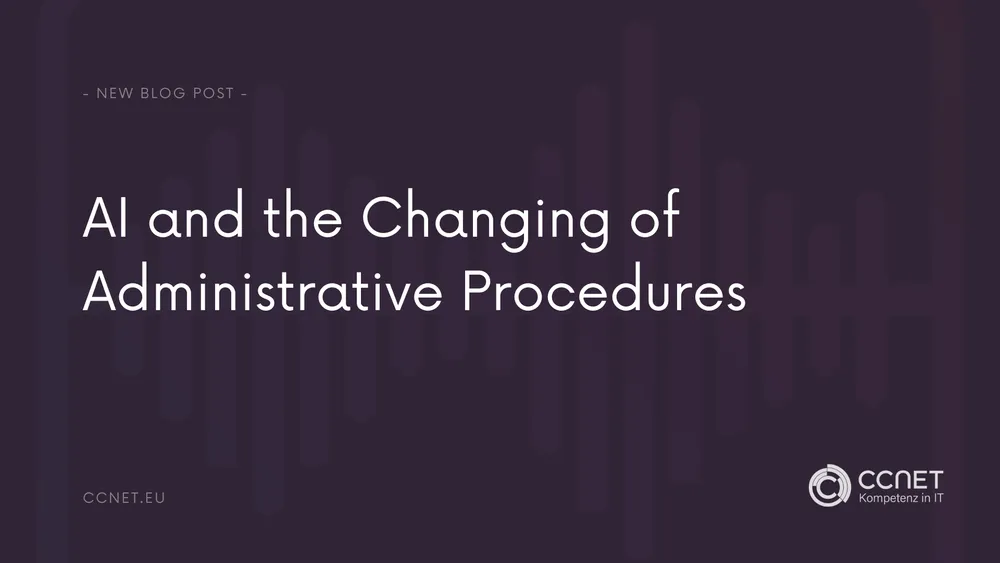
CCNet
Aug 9, 2024 • 3 min read

The Importance of Interdisciplinary Teams in Legal and Administrative Informatics
In the modern world where law and technology are increasingly intertwined, giving rise to complex challenges, interdisciplinary teams are becoming increasingly important. These teams bring together experts from various fields such as law, computer science, administration, ethics, and psychology, playing a crucial role in shaping laws and procedures. Their collaboration enables the development of solutions that are not only legally sound and technologically feasible but also consider ethical and psychological aspects. This holistic approach is essential to meet the constantly evolving needs of modern society and ensure that innovations align with fundamental values and human needs.
If you have any further questions, contact us: contact
The Role of Interdisciplinary Teams
Interdisciplinary teams bridge the gap between legal expertise and technological proficiency to precisely coordinate the digitization and automation of administrative processes. Collaboration between legal professionals, software developers, and enforcement experts ensures that procedures are digitally designed from the outset, taking into account existing IT applications and data. This promotes efficiency, accuracy, and seamless integration of new technologies into the legal framework.
Benefits of Interdisciplinary Teams
-
Enhancement of Law Quality: By involving technology experts, laws can be crafted to be not only legally but also technically feasible. This contributes to more efficient and error-free implementation by identifying and addressing potential technical hurdles early on. Additionally, collaboration with industry specialists ensures that legal frameworks align with current technological capabilities and industry standards.
-
Innovative Solutions: Interdisciplinary teams foster the development of innovative solutions by bringing together diverse perspectives and expertise. This can lead to more creative and effective problem-solving approaches that may go beyond conventional legal thinking. Moreover, incorporating feedback from end-users and stakeholders throughout the development process encourages iterative refinement and the exploration of novel ideas.
-
Increased Transparency and Comprehensibility: Utilizing visual aids such as tree diagrams and flowcharts can make complex legal processes and data flows understandable. This enhances communication within the team and with stakeholders since complex concepts can be visually represented, leading to improved collaboration and more effective decision-making. Furthermore, leveraging interactive tools and user-friendly interfaces enhances accessibility and facilitates greater understanding of legal concepts for non-experts.
Challenges and Solutions
Working in interdisciplinary teams is not without challenges. Different jargons and work styles can lead to communication issues that disrupt workflow. Regular training, both in terms of content and communication techniques, and joint workshops can help foster better understanding and more effective collaboration. Additionally, defining clear goals and processes to structure collaboration and minimize conflicts, while providing continuous feedback, supports progress and improves team dynamics.
Conclusion
Interdisciplinary teams are crucial for the successful digitization and automation in the legal field. They enable a comprehensive consideration of challenges and ensure that both the legal and technical aspects are addressed in the new systems. The importance of these teams cannot be overstated, as they bridge gaps between different areas of expertise. The ongoing integration of law and informatics will continue to position these teams as an integral part of the modern legal system. They contribute to developing innovative solutions that meet legal requirements while fully harnessing the potential of technology and ensuring that humanity and ethics are preserved in the decision-making process.
How do you envision the future of collaboration between lawyers and technologists in the development of administrative systems? Are there specific areas where you see potential for improved interdisciplinary collaboration?
What are the advantages of interdisciplinary teams in legal and administrative informatics?
Interdisciplinary teams improve the quality of legislation by ensuring that laws are technically feasible. They also promote innovative solutions and increase transparency by presenting complex legal processes in an understandable way.
How do interdisciplinary teams contribute to the digitisation of administrative procedures?
These teams bridge the gap between legal expertise and technological know-how, resulting in the efficient and error-free implementation of digital administrative procedures.
What are the challenges of working in interdisciplinary teams?
Communication problems due to different technical languages and working methods can impair the workflow. These challenges can be overcome through regular training and joint workshops.
How do interdisciplinary teams promote innovative solutions in the legal field?
By bringing together different perspectives and expertise, interdisciplinary teams develop creative and effective solutions that go beyond conventional legal thinking.
What is the benefit of visual aids such as flowcharts in interdisciplinary teams?
Visual aids improve the comprehensibility of complex processes and data flows, which facilitates communication within the team and with stakeholders and optimises decision-making.


